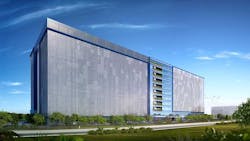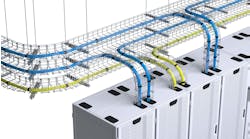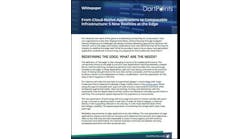Decreasing Power and Water Today Will Help Data Centers Reach Sustainability Goals Tomorrow
Kris Holla, Group Vice President and Chief Sales Officer for Nortek Air Solutions, explores how data centers can best reach their future sustainability goals.
Kris Holla, Group Vice President and Chief Sales Officer for Nortek Air Solutions
It’s no secret that power and water conservation is challenging the data center industry today.
The explosive growth of data usage, driven recently from IoT, machine learning, artificial intelligence, autonomous cars, 5G, social media and other expanding innovations, is taxing conventional data center cooling solutions. Old school, energy inefficient equipment cooling technologies, such as chiller/cooling towers and direct mechanical cooling, will lose popularity as data centers are pressured toward more sustainable infrastructure solutions.
We all need to be responsible corporate citizens and transition toward climate change and environmental stewardship. For example, Microsoft announced Jan. 16, 2020 that it will become carbon negative by 2030. Microsoft CEO Satya Nadella also announced a new $1 billion climate innovation fund to accelerate the global development of carbon reduction, capture and removal technologies. Data leaders are moving toward their sustainability goals.
Microsoft is on the right path. If the data-center industry doesn’t solve the power and water consumption challenge itself, governments are ready to step in and dictate where data centers can locate, mandates for efficiency or whether they can continue to operate at all in their jurisdictions. Governmental power and water power consumption regulation can potentially stunt the industry’s future growth curve. Furthermore, many global regions simply don’t have the power and water resources available to accommodate large co-location and hyperscale facility cooling requirements.
The Republic of Singapore’s limited power and water resources is a prime example. Its current water demand is approximately 606-million m3/yr, which is enough to fill 285,430 Olympic size swimming pools, according to data collected by Nalco Water, a Naperville, Ill.-based water treatment and process improvement company. If all new Singapore data centers stay on the path of reaching a goal of approximately 3-GW of data center capacity, the country would be allocating nearly 10% of its water to just cooling data centers with conventional equipment. Even worse, the power needed to reach that 3-GW goal will represent 18% of Singapore’s total electric consumption.
North America has more resources than Singapore; however, water conservation and sustainability is still a critically important agenda for every large U.S. company, especially environmentally-conscious firms, such as Facebook, Google and other social media giants. The larger their data centers become, the more likely local governments may reject building permits, because of the anticipated excessive power and water consumption. For example, data centers in the U.S. alone will use an estimated 174 billion gallons of water in 2020.
To offset this challenge, large corporations and data center operators are creating chief sustainability officer (CSO) positions. These CSOs are pressuring cooling equipment manufacturers to develop more revolutionary and radically sustainable technological solutions.
Consequently, cooling manufacturers, such as Nortek Air Solutions, have partnered with the world’s largest social media company, Facebook to co-develop a new generation of data center cooling called StatePoint. This Indirect Evaporative Cooling using semi-permeable exchanger (SPEX) technology completely separates water and air flow layers.This new liquid cooling methodology has been lab tested as the most sustainable data center cooling technology available today, because it potentially reduces liquid cooling water and power consumption by up to 50- and 20%, respectively.
The SPEX records the lowest WUE and PUE of all indirect evaporative cooling methods, because of the recent development of a unique microporous membrane heat exchanger. Furthermore, the membrane is less susceptible to scaling and minimizes the threat of Legionella, the potentially fatal airborne bacteria that poorly-maintained cooling towers and conventional evaporative coolers are known to nurture, harbor and distribute to nearby populations.
As the industry continues its exponential expansion, anticipated water and power shortages will have an effect on future data center total cost of ownership (TCO) and possibly dictate where and if operators can build a new facility, or continue operating existing sites.
Now Facebook plans to use the technology in its future 170,000-m3 Singapore hyperscale data center, which is a candidate for world’s largest.
One advantage of SPEX technology is its flexibility to operate in a variety of climates as illustrated by its use in the decidedly different temperature/humidity environments of Ireland and Singapore. SPEX technology has three modes of operation it can switch to automatically to operate at the greatest efficiency, depending on ambient conditions: 1) economizer; 2) adiabatic; and 3) evaporative cooling. None of the modes use refrigerants. However, vapor-compression chiller technology (trim cooling) can supplement the SPEX technology in extreme hot and humid environments, but it is significantly scaled down in size (and upfront capital costs) compared to dedicated chiller systems supplying 100-percent of the data center cooling.
Unlike direct evaporative cooling, outdoor air doesn’t come in direct contact with the evaporative water process in SPEX technology. While direct evaporative cooling is excellent for many climates, it’s still maintenance intensive because of potentially polluted outdoor air and water mineral scaling. For example, less than a decade ago, London data centers were shut down for days due to an Icelandic volcano eruption that polluted the air throughout Northern Europe. SPEX technology circumvents these obstacles, because a thin, flexible and hydrophobic microporous membrane functions as a heat exchanger that virtually separates the water from the air. Water flow is sealed between the vapor permeable membranes, which eliminate water carryover into the air stream.
Separating the water from the air is one reason this methodology uses up to 50% less water than conventional systems. Furthermore, the absence of compressors cuts energy use significantly and leads to the lowest PUE in the data center industry.
While Facebook and other social media giants are using this technology in new data-center construction, it’s also very adaptable for retrofits, because it’s a direct replacement for energy and water intensive chiller/cooling tower and direct mechanical technologies. The chilled water loop distribution network remains in place to circulate the SPEX chilled water to the existing data center’s fan coil walls, in-row cooling coils, cold plate, rear door heat exchangers or any other hydronic cooling method.
The data center industry’s future power and water stewardship plans for tomorrow should begin today. As the industry continues its exponential expansion, anticipated water and power shortages will have an effect on future data center total cost of ownership (TCO) and possibly dictate where and if operators can build a new facility, or continue operating existing sites.
Kris Holla is Group Vice President and Chief Sales Officer for Nortek Air Solutions, in St. Louis, Mo.





